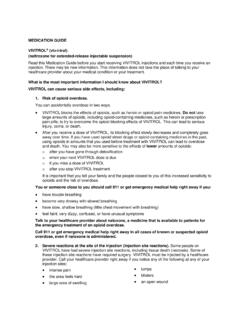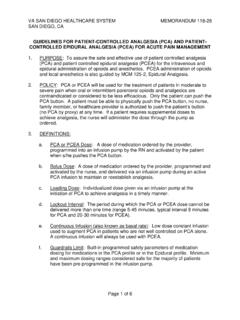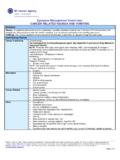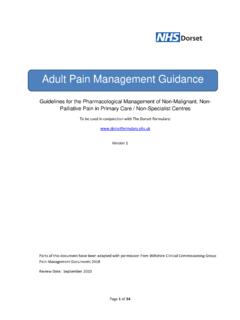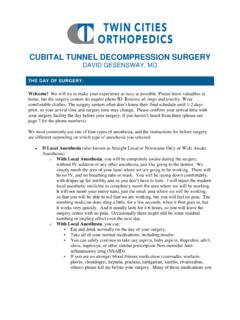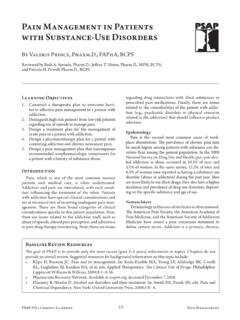Transcription of PATIENT SAFETY CARD FOR EMERGENCY PAIN MANAGEMENT
1 PATIENT SAFETY CARD FOR EMERGENCY pain MANAGEMENTIf you ever need EMERGENCY medical treatment, your pain MANAGEMENT Card lets other doctors and nurses know that you are taking VIVITROL (naltrexone for extended-release injectable suspension). This card includes information that will help them provide you with the best possible you are being treated with VIVITROL, it is important that you print this page, cut out the card below, fold in half and tape shut. Keep card with you at all , cut out, fold in half and tape see attached Prescribing Information and Medication Guide. Please review Medication Guide with your healthcare Information For EMERGENCY pain ManagementI am currently taking VIVITROL (naltrexone for extended-release injectable suspension), an opioid antagonist.
2 Please see the back of this card for important information about pain Name: EMERGENCY contact name: EMERGENCY contact number:My doctor:My doctor s phone number: 2013 Alkermes, Inc. All rights reserved. VIV-001315 Printed in 1-888-235-8008 For Prescribing Information and Medication Guide, please visit Medical Personnel Treating Me In An EmergencyCall 1-888-235-8008 For Prescribing Information and Medication Guide, please visit The PATIENT is taking VIVITROL, an opioid antagonist. Suggestions for pain MANAGEMENT include regional analgesia or use of non-opioid analgesics. If opioid therapy is required, it should be administered by healthcare providers specifically trained in the use of anesthetic drugs and MANAGEMENT of respiratory effects of potent opioids, specifically the establishment and maintenance of a patent airway and assisted ventilation.
3 The PATIENT should be monitored closely in a setting equipped and staffed for cardiopulmonary of last injection:HIGHLIGHTS OF PRESCRIBING INFORMATIONT hese highlights do not include all the information needed to use VIVITROL safely and effectively. See full prescribing information for (naltrexone for extended-release injectable suspension), for intramuscular useInitial Approval: 1984 RECENT MAJOR CHANGESD osage and Administration ( ) 09/2019 Warnings and Precautions ( ) 09/2019 INDICATIONS AND USAGE VIVITROL contains naltrexone, an opioid antagonist, and is indicated for the treatment of alcohol dependence in patients who are able to abstain from alcohol in an outpatient setting prior to initiation of treatment with VIVITROL.
4 Patients should not be actively drinking at the time of initial VIVITROL administration ( ). VIVITROL is indicated for the prevention of relapse to opioid dependence, following opioid detoxification ( ). VIVITROL should be part of a comprehensive MANAGEMENT program that includes psychosocial support (1).DOSAGE AND ADMINISTRATION VIVITROL must be prepared and administered by a healthcare provider ( , ). Prior to initiating VIVITROL, an opioid-free duration of a minimum of 7 10 days is recommended for patients, to avoid precipitation of opioid withdrawal that may be severe enough to require hospitalization ( ). The recommended dose of VIVITROL is 380 mg delivered intramuscularly (IM) as a gluteal injection, every 4 weeks or once a month, alternating buttocks for each subsequent injection, using the carton components provided ( ).
5 VIVITROL must not be administered intravenously or subcutaneously ( ). See Full Prescribing Information for complete Directions for Use ( ).DOSAGE FORMS AND STRENGTHSVIVITROL is an injectable suspension containing 380 mg of naltrexone in a microsphere formulation in a single-dose vial. (3).CONTRAINDICATIONSVIVITROL is contraindicated in: Patients receiving opioid analgesics (4). Patients with current physiologic opioid dependence (4). Patients in acute opioid withdrawal (4). Any individual who has failed the naloxone challenge test or has a positive urine screen for opioids (4). Patients who have previously exhibited hypersensitivity to naltrexone, polylactide-co-glycolide (PLG), carboxymethylcellulose, or any other components of the diluent (4).
6 WARNINGS AND PRECAUTIONS Vulnerability to Opioid Overdose: Following VIVITROL treatment opioid tolerance is reduced from pretreatment baseline, and patients are vulnerable to potentially fatal overdose at the end of a dosing interval, after missing a dose, or after discontinuing VIVITROL treatment. Attempts to overcome blockade may also lead to fatal overdose ( ). Injection Site Reactions: VIVITROL must be prepared and administered by a healthcare provider. In some cases, injection site reactions may be very severe. Some cases of injection site reactions required surgical intervention ( ). Precipitation of Opioid Withdrawal: Opioid-dependent and opioid-using patients, including those being treated for alcohol dependence, should be opioid-free before starting VIVITROL treatment, and should notify healthcare providers of any recent opioid use.
7 An opioid-free duration of a minimum of 7 10 days is recommended for patients to avoid precipitation of opioid withdrawal that may be severe enough to require hospitalization. ( ). Hepatotoxicity: Cases of hepatitis and clinically significant liver dysfunction were observed in association with VIVITROL treatment during the clinical development program and in the postmarketing period. Discontinue use of VIVITROL in the event of symptoms or signs of acute hepatitis ( ). Depression and Suicidality: Monitor patients for the development of depression or suicidal thinking ( ). When Reversal of VIVITROL Blockade Is Required for pain MANAGEMENT : In an EMERGENCY situation in patients receiving VIVITROL, suggestions for pain MANAGEMENT include regional analgesia or use of non-opioid analgesics ( ).
8 ADVERSE REACTIONSThe adverse events seen most frequently in association with VIVITROL therapy for alcohol dependence ( , those occurring in 5% and at least twice as frequently with VIVITROL than placebo) include nausea, vomiting, injection site reactions (including induration, pruritus, nodules and swelling), muscle cramps, dizziness or syncope, somnolence or sedation, anorexia, decreased appetite or other appetite disorders (6).The adverse events seen most frequently in association with VIVITROL therapy in opioid-dependent patients ( , those occurring in 2% of patients treated with VIVITROL and at least twice as frequently with VIVITROL than placebo) were hepatic enzyme abnormalities, injection site pain , nasopharyngitis, insomnia, and toothache (6).
9 To report SUSPECTED ADVERSE REACTIONS, contact Alkermes, Inc. at 1-800-VIVITROL (1-800-848-4876) and/or email: or FDA at 1-800-FDA-1088 or INTERACTIONSN altrexone antagonizes the effects of opioid-containing medicines, such as cough and cold remedies, antidiarrheal preparations, and opioid analgesics (7).USE IN SPECIFIC POPULATIONS Caution is recommended in administering VIVITROL to patients with moderate to severe renal impairment ( ). VIVITROL pharmacokinetics have not been evaluated in subjects with severe hepatic impairment ( ).See 17 for PATIENT COUNSELING INFORMATION and FDA-approved Medication GuideRevised: 07/2020 FULL PRESCRIBING INFORMATION1 INDICATIONS AND USAGET reatment with VIVITROL should be part of a comprehensive MANAGEMENT program that includes psychosocial Alcohol DependenceVIVITROL is indicated for the treatment of alcohol dependence in patients who are able to abstain from alcohol in an outpatient setting prior to initiation of treatment with VIVITROL.
10 Patients should not be actively drinking at the time of initial VIVITROL Opioid DependenceVIVITROL is indicated for the prevention of relapse to opioid dependence, following opioid DOSAGE AND Important Dosage and Administration InformationVIVITROL must be prepared and administered by a healthcare products should be visually inspected for particulate matter and discoloration prior to administration whenever solution and container permit. A properly mixed suspension will be milky white, will not contain clumps, and will move freely down the wall of the vial [see Dosage and Administration ( )].Prior to initiating VIVITROL, an opioid-free duration of a minimum of 7 10 days is recommended for patients, to avoid precipitation of opioid withdrawal that may be severe enough to require hospitalization [see Warnings and Precautions ( )].
